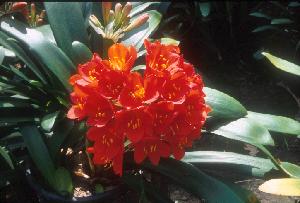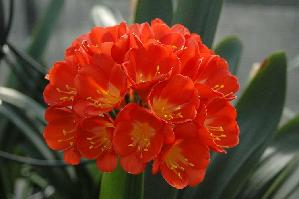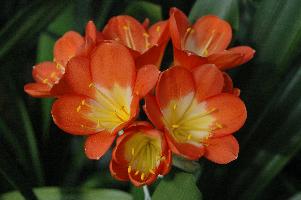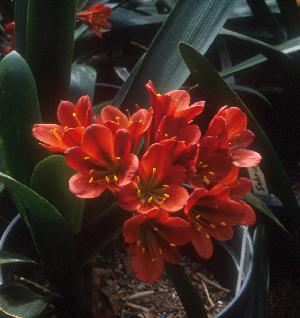Clones and Cultivars
 The classic red clivia was Conway's 'Doris', and many of us bought it. Just as good a red, perhaps a better one, is Conway's 'Abigail'.
The classic red clivia was Conway's 'Doris', and many of us bought it. Just as good a red, perhaps a better one, is Conway's 'Abigail'.
Conway's 'Doris'
 Other reds that we have had include the regular Solomone Red strain, and Solomone's selected "Reddest" strain.
Other reds that we have had include the regular Solomone Red strain, and Solomone's selected "Reddest" strain.
Solomone Red Clivia
We look for reds wherever we can find them. A nice red turned up in a batch of pastels received from Kevin Akins; I call that one "Kevin's Red."
 Years ago, Pen Henry sent me a batch of seeds from her breeding program. A few of those resulted in plants that are now blooming size, labeled "Pen Henry Reds." I am sure Pen's red is a complex interspecific hybrid, since the berries are yellow with only a little pink coloration. I think her reds derive from her 'Tropical Splendor' strain of interspecific hybrids. I'll talk about berry colors some other time.
Years ago, Pen Henry sent me a batch of seeds from her breeding program. A few of those resulted in plants that are now blooming size, labeled "Pen Henry Reds." I am sure Pen's red is a complex interspecific hybrid, since the berries are yellow with only a little pink coloration. I think her reds derive from her 'Tropical Splendor' strain of interspecific hybrids. I'll talk about berry colors some other time.
Pen Henry Red Clivia
 Other Conway plants with notable red coloration in the flowers include 'Sabrina Delphine', 'Fleur de Lis', and 'Jean Delphine'. In my greenhouse, some of these have not done well: 'Abigail', 'Doris', 'Fleur de Lis', 'Jean Delphine', 'Sabrina Delphine', and the Solomone "Reddest." I suspect that the Solomone red lines have a lot of 'Doris' genes in their backgrounds. I have one plant of my cross ['Sabrina Delphine' x 'Doris'] that has suvived to just about bloom size. I am eagerly waiting to see what its flowers look like.
Other Conway plants with notable red coloration in the flowers include 'Sabrina Delphine', 'Fleur de Lis', and 'Jean Delphine'. In my greenhouse, some of these have not done well: 'Abigail', 'Doris', 'Fleur de Lis', 'Jean Delphine', 'Sabrina Delphine', and the Solomone "Reddest." I suspect that the Solomone red lines have a lot of 'Doris' genes in their backgrounds. I have one plant of my cross ['Sabrina Delphine' x 'Doris'] that has suvived to just about bloom size. I am eagerly waiting to see what its flowers look like.
Clivia 'Jean Delphine'
Many red clivia have tulip shaped flowers. This seems to be genetically linked with the genes for intense red color. On the other hand, some of the South African reds and the Belgian reds tend to have more open, flaring flower form. Some of my [Miné X Bing Wiese Green Throat] from South Africa have good flower form, decent red color, a white ground color and throat, and a rich green heart. At least sometimes.
The Best Reds in California
While Conway's 'Doris' and his 'Abigail' bloom quite a nice red color in southern California, there are redder reds on clivias there. Plants from the cross ['Abigail' x 'Doris'] made by Maris Andersons in Santa Barbara have excellent deep red flowers in a nice umbel. Jim Comstock has produced a few of the very reddest reds I have ever seen. I do not know the names of any of the Comstock red clones, and Comstock's breeding materials are not available to anyone so far as I have ever heard.
I repeated the ['Abigail' x 'Doris'] cross myself here in Indiana, and we have about 6 surviving plants from that batch. At least two of them are actually large enough to flower this year, if they happen to feel like it.
Good gardening, from here in central Indiana
Jim